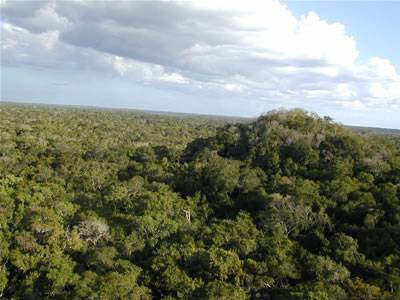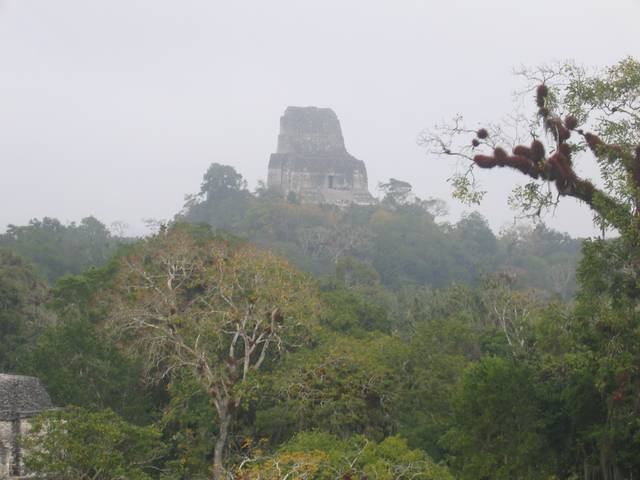
El Mirador is a large site of Mayan ruins in the Petén department of Guatemala.
The reasons that El Mirador is not swamped with tourists are its inaccessibility and, although a lot of work being done here, most of this huge site involves many unrestored mounds and pyramids in the jungle. Structure 34 is an exception, where some interesting figures were unearthed and an entire wall has been laid bare. Danta is another exception, where work to stabilize it was done. Once a person has hiked to the top of El Tigre, the view that awaits is mostly of jungle and other ruins, such as Calakmul and Nakbé in the distance. However, any mound or group of mounds that you can see as far to the horizon are former cities. It is the idea of lost cities the jungle that brings people to see it. Because of serious ongoing work, this site will become more and more visibly intriguing as time goes on.
El Mirador flourished as a trading center from around 200 BCE to 150 CE during the Maya Pre-Classic Period. With a population as high as 80,000, it was one of the first large cities in North America. In the mid second century CE the entire Mirador Basin with its numerous other cities and villages became rapidly depopulated. There is little evidence of a population until there was a modest one in the Late Classic Period, and there is no permanent population today. On April 18, 2002, President Alfonso Portillo signed legislation, which established the Mirador Basin National Monument as a Special Archaeological Zone. This is intended to provide for the permanent protection of 240,000 ha of tropical rainforest in this area, which surrounds the oldest and largest Maya archaeological sites in Mesoamerica. The Mirador Basin National Monument is designed as a wilderness preserve without roads. However, events of 2005 in Guatemala have pitted ranching and logging interests against this effort. Even some locals who do not see how tourism in the area will benefit them yet are in favor of what will result in roads, short term logging, non-sustainable swidden agriculture and ranches where once there was rain forest. See http://news.mongabay.com/2005/1113-wsj.html.
It's not a rain forest for at least half of the year. However, there are a good number of bajos en route that are muddy through much of the year. The good news is that the portion from Tintal to El Mirador is now primarily atop the ancient causeway between them, so there is a lot less traversing bajos.
Animals and insects were surprisingly sparse in January, but were fairly common in an earlier July trip. It is very dry for enough of the year to make survival a problem. You will most likely hear birds, but may see them from time to time. There are some monkeys, both howler and spider. The area has some interesting butterflies, spiders and an occasional snake.
Tropical, but it will get cool toward morning. In December and January, you will be glad that your guide brought blankets for sleeping on your solid cloth hammock. You will enjoy a hot drink in the morning year around.
There is a Q60Q entry fee per visitor .

The city's main group of buildings covers two square kilometers and many were built on a grand scale. The largest pyramid at El Mirador, El Tigre, has six times the surface area as Temple IV at Tikal and is 55 meters tall. The Danta Complex is about 300 meters wide on each side of the bottom base, which is 7 meters high and supports a series of buildings. The next and smaller platform rises another 7 meters. Above that is another platform around 21 meters high, which is topped off by three pyramids, the tallest of which is 21 meters high. The total height is 70 meters, making it taller than Temple IV at Tikal. Recent finds include a now reconstructed frieze, showing the Hero Twins of the Popul Vuh and a mural.
Current tours also can involve visiting Nakbé and will take longer than seeing just the one site. They require stamina and involve riding horses or walking for around 27-30 hours over the course of five days. Saddle horses or mules are good to have along, but if you are not going in the rainy season, you will probably alternate walking with riding and may want to share a ride among two of you. Given a choice of horse and mule, keep in mind that the mule is far more likely to obey your reined demands to avoid scraping you against some thorny tree on a trip.
Buy what you need beforehand. The guards at any Guatemalan ruin rotate in for 21 days at a time, so consider buying and bringing "items" for them. Food treats or cigarettes would be enjoyed. DO NOT bring liquor to give them. Any worker in the Mirador Basin caught with alcohol will be banned for life from ever working there again. Be sure to bring and use insect repellent containing 100% deet. Also spray pants legs and socks with Permethrin.
Food is included in any outfitted trip to El Mirador, but protein may be in short supply for most meals. Bring snacks and granola bars.
BYO, except for water. On cool mornings, unless you really like instant coffee every day, hot chocolate or latte mixes will hit the spot.
The last thing that almost anyone connected with these trips wants is for anything bad to happen to travelers. The local economy depends on good trips happening. Cooks are very careful to cook in such a way that no one gets sick and I think that thieves would receive a cold and dangerous reception there. Always have a flashlight handy when leaving your hammock in the dark. Just going a little way to urinate might turn you around. A very small one that you always keep in the same pocket is good for this. Probably the best flashlight you can have in the evening is one you can wear on your head. Just don't point it so it is in people's eyes.
